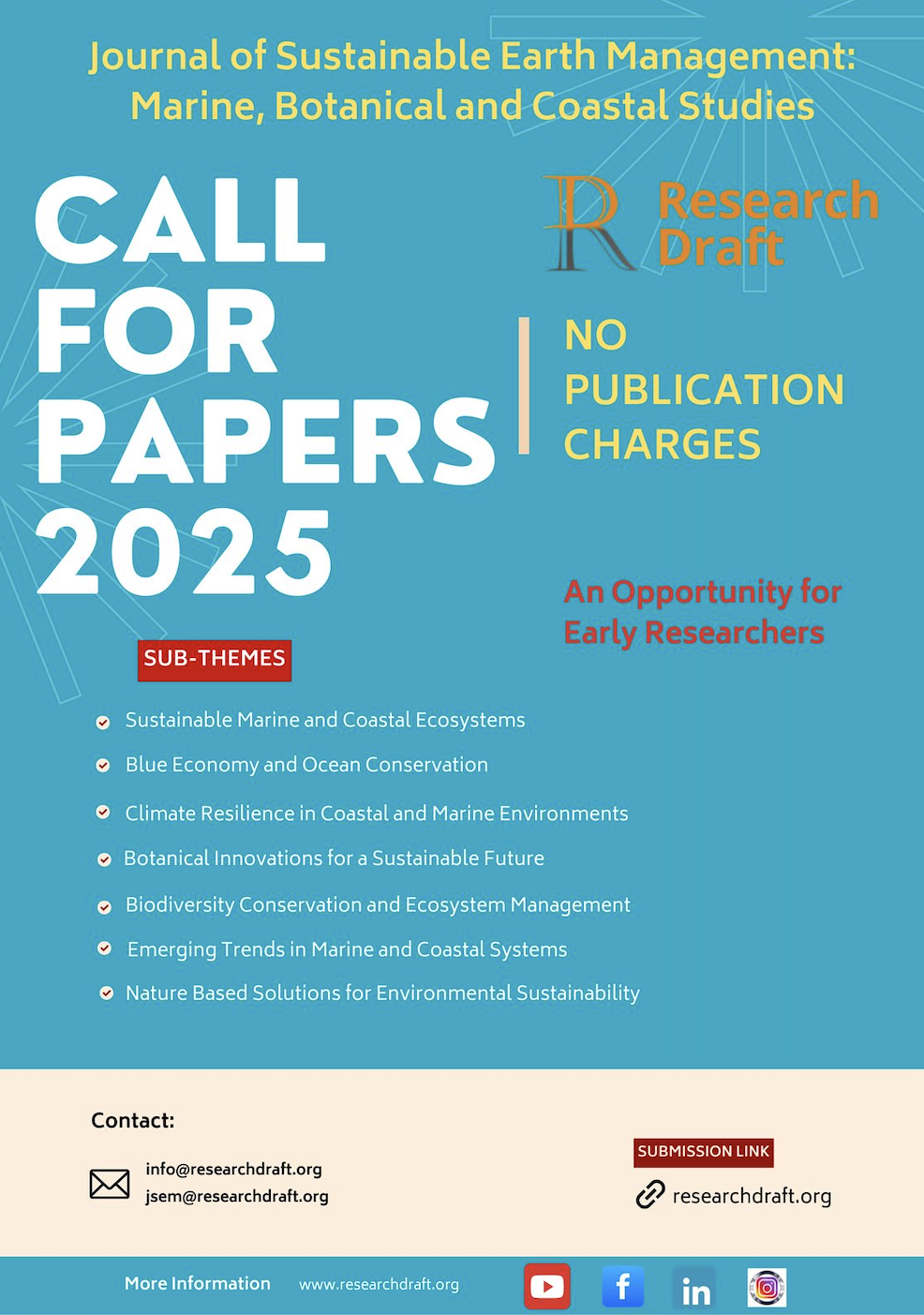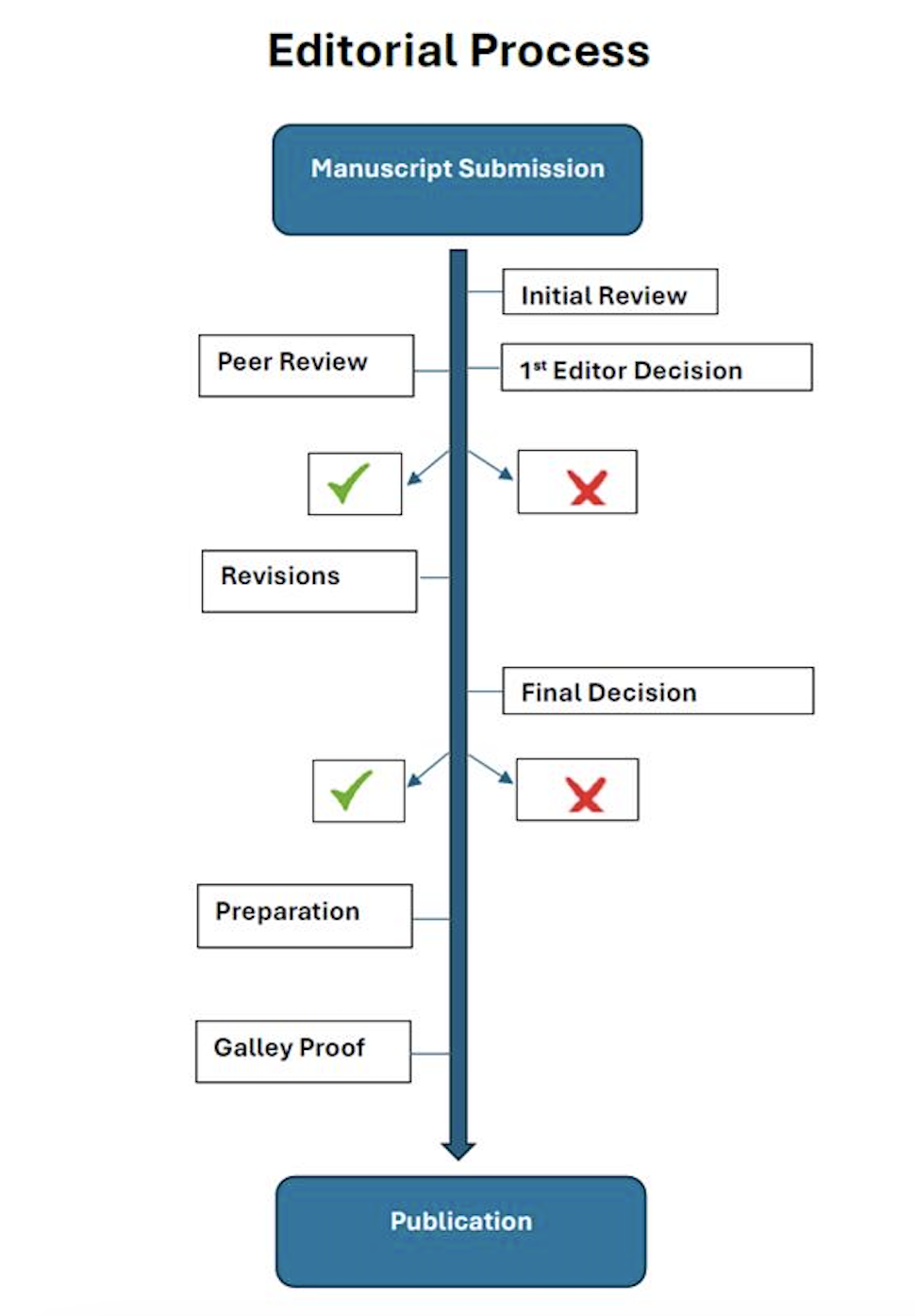

Authors are invited to make a submission to this journal. All submissions will be assessed by an editor to determine whether they meet the aims and scope of this journal. Those considered to be a good fit will be sent for peer review before determining whether they will be accepted or rejected.
Before making a submission, authors are responsible for obtaining permission to publish any material included with the submission, such as photos, documents and datasets. All authors identified on the submission must consent to be identified as an author. Where appropriate, research should be approved by an appropriate ethics committee in accordance with the legal requirements of the study's country.
An editor may desk reject a submission if it does not meet minimum standards of quality. Before submitting, please ensure that the study design and research argument are structured and articulated properly. The title should be concise and the abstract should be able to stand on its own. This will increase the likelihood of reviewers agreeing to review the paper. When you're satisfied that your submission meets this standard, please follow the checklist below to prepare your submission.
Before submitting your manuscript, please ensure that it adheres to the following international standards of scholarly publishing.
Authors Guidelines
Article Title: The manuscript title should reflect the aim, purpose, and offer a detailed summary of the key experimental or theoretical research conducted.
Authors Name: The authors' names must be listed according to their contributions, the list of authors cannot be altered, including during the modification, revision, or galley proof stages.
F. A. Name1*, S. A. Name2 and T. A. Name1,2
1 Department, Institution, City, Country
2 Department, Institution, City, Country
*Corresponding Author’s E-mail : HYPERLINK "mailto:name@institution.edu"name@institution.edu
Abstract: The abstract should summarize the contents of the paper in short terms including objective, methods, findings and conclusion with its statistical significance. i.e. 200-250 words.
Keywords: Five Keywords, general and innovative, field relevant and easy to search.
Note: Key words should not be present in the title of the manuscript.
Abbreviations: Any nonstandard abbreviations should be kept to a minimum and must be defined in the text the first time they are introduced; however standard abbreviations should be employed throughout the manuscript without periods.
Introduction: Must contain a comprehensive summary of existing research relevant to the study, identifying key findings, gaps, and areas for further exploration.
Materials and Methods: Describe all the details of material and methods such as study location with map, sampling methods, protocols or indexes, the experimental methods should be outlined with enough detail to allow others to replicate the experiments. Innovative experimental techniques should be thoroughly explained, while established procedures can be cited through relevant literature, including references to both the original and any subsequent modifications.
Ethical approval: Manuscripts presenting data from animal and/or human research must indicate the committee and institution that granted approval for the experimental protocols used in the study.
Statistical analysis: Authors should specify the software and its version utilized in the research, along with the tests applied for data analysis.
Results and Discussion: Give your results in the form of figures and tables and discuss while citing literature. Tables and figures should be clear and streamlined to effectively present and clarify the experimental data. Data should not be repeated in multiple figures or presented in both a figure and a table.
Table SEQ "Table" \* MERGEFORMAT 1. Table captions should be placed above the tables
Heading level
Example
Font size and style
Title (centered)
Lecture Notes
14 point, bold
1st-level heading
1 Introduction
12 point, bold
2nd-level heading
2.1 Printing Area
10 point, bold
Fig. SEQ "Figure" \* MERGEFORMAT 1. A figure caption is always placed below the illustration. Short captions are centered, while long ones are justified.
Conclusion: For citations of references, use the numeric style. Conclude here your study please be general and conclusive between 100-150 words.
Acknowledgements: You can acknowledge your donors and persons who assisted you technically in carrying out this study.
Citation in Text:
In the text, when citing a single author, use the format (e.g., Stephens, 2018).
For two authors, both names should be separated with an "and" (e.g., Brown and Endrizzi, 2016).
For works by more than two authors, use the first author's name followed by "et al (for e.g.; Brown et al., 2017)
When citing multiple sources in the text, they should be arranged in chronological order (e.g., Stephens, 2009; Brown & Endrizzi, 2010; Ashraf et al., 2012; Wang, 2014; Sajid & Aqeel, 2018).
If the same author has multiple publications in the same year, differentiate the references with a, b, c, etc. (e.g., Ashraf et al., 2004a, 2004b; Wang & Liu, 2018).
Citation in References:
Journal Article
Author’s Sir Name, first name abbreviated., (year). Title of article. Journal name (Full name), Volume (Issue), Page numbers. DOI
Examples
Elmer, W., & White, J.C., (2018). The future of nanotechnology in plant pathology. Annual review of phytopathology, 56(1),111-133.
Pugnaire, F.I., Morillo, J.A., Peuelas, J., Reich, P.B., Bardgett, R.D., (2019). Climate change effects on plant-soil feedbacks and consequences for biodiversity and functioning of terrestrial ecosystems. Science advances, 5(2),18-34.
Book
Author’s Sir Name, first name abbreviated., (year). Title of the Book. Edition number, Publisher name. DOI
Example
Ahmad, P., Prasad, M.N.V., (2011). Sustainable Climate. 5th Edition, Springer. DOI
Book Chapter
Author’s Sir Name, first name abbreviated., (year). Title of the Chapter. Book Title, Edition number, Publisher name, Page numbers. DOI
Example
Parmesan, C., (2015). Plants and climate change: complexities and surprises. Sustainable Climate, 3rd Edition, Springer, 849-864. DOI
Important Note:
Total paper should consist of minimum 2000 words containing section of Title, Abstract, Keywords, Introduction, Material and Methods, Results and Discussion and References.
A minimum of 3 figures/Tables and latest references should be present in it.
All text should be in Times New Roman, font size 12 and justified.
The submitted manuscript should be according to the HEC plagiarism policy.
All submissions must meet the following requirements.
Submission declaration
Authors retain the copyright to their work and grant the Journal of Sustainable Earth Management (JSEM), the right of first publication under a Creative Commons Attribution 4.0 International (CC BY 4.0) license. This license allows others to share, adapt, and reuse the work for any purpose, including commercial use, as long as appropriate credit is given to the original authors and the journal.
By submitting a manuscript, authors confirm that the work has not been published previously (except as an abstract, lecture, or academic thesis), is not under review elsewhere, and has been approved by all authors and relevant authorities. Once accepted, the article will be openly accessible under the CC BY 4.0 license, ensuring wide dissemination and reuse with proper attribution.
At Journal of Sustainable Earth Management: Marine, Botanical, and Coastal Studies, we are committed to protecting the privacy and personal information of our authors, reviewers, and readers. This privacy statement outlines how we collect, use, and safeguard your data in compliance with international data protection regulations.
1. Collection of Personal Information
We may collect the following types of personal data:
✅ Authors: Names, affiliations, email addresses, ORCID iDs, and contact details provided during manuscript submission.
✅ Reviewers: Names, affiliations, contact details, and areas of expertise.
✅ Readers: Email addresses for newsletter subscriptions and updates.
We collect this data solely for academic publishing, peer review, and communication purposes.
2. Use of Information
The collected information is used for:
✅ Managing manuscript submissions and peer review processes.
✅ Communicating with authors, reviewers, and editorial board members.
✅ Publishing accepted research articles with proper author attribution.
✅ Notifying users about journal updates, calls for papers, and events.
✅ Ensuring compliance with ethical publishing practices.
We do not use personal data for commercial purposes or share it with third parties without consent.
3. Data Protection & Security
We implement industry-standard security measures to protect your data from unauthorized access, loss, or misuse. This includes:
✅ Secure storage of submission data.
✅ Limited access to personal data by authorized personnel only.
✅ Regular updates to our data security protocols.
4. Sharing of Information
We do not sell or distribute personal data. However, we may share information in the following cases:
✅ With indexing and abstracting services to enhance research visibility.
✅ When required by law or regulatory authorities.
✅ In case of ethical investigations (e.g., plagiarism, conflict of interest).
5. Cookies & Website Analytics
Our journal’s website may use cookies to improve user experience and track website analytics. Users can disable cookies through browser settings if they prefer not to be tracked.
6. Retention of Data
We retain personal data for as long as necessary for publishing, academic communication, and record-keeping purposes. Users may request data deletion upon journal withdrawal or retirement.
7. User Rights
Users have the right to:
✅ Request access to their personal data.
✅ Request correction or deletion of inaccurate data.
✅ Opt-out of newsletters or promotional emails.
For any requests, please contact info@researchdraft.org
8. Updates to Privacy Policy
This privacy statement may be updated periodically to reflect changes in policies or regulations. Users will be notified of any significant updates.
9. Contact Information
For any privacy-related concerns, please contact:
By submitting to or interacting with the Journal of Sustainable Earth Management (JSEM), you acknowledge and agree to this privacy policy.
